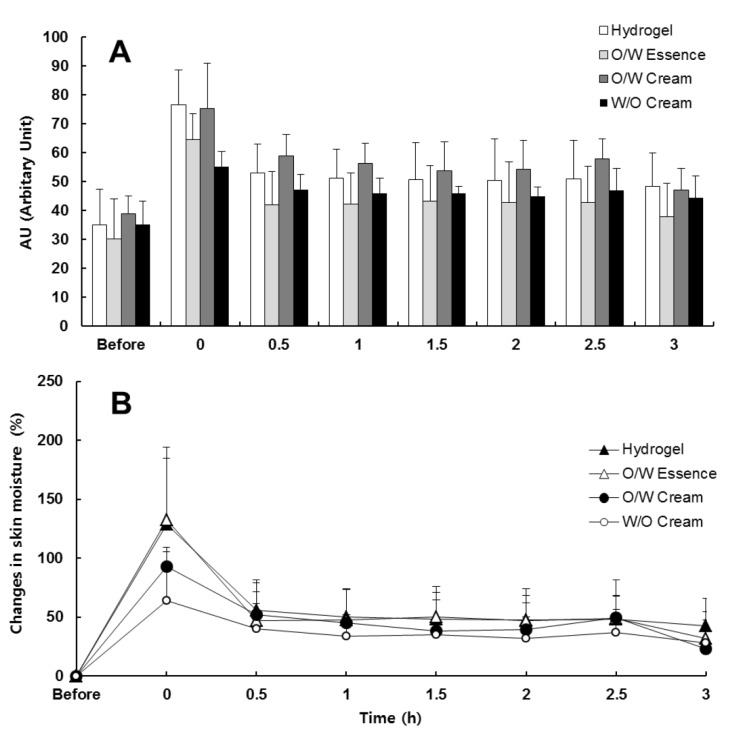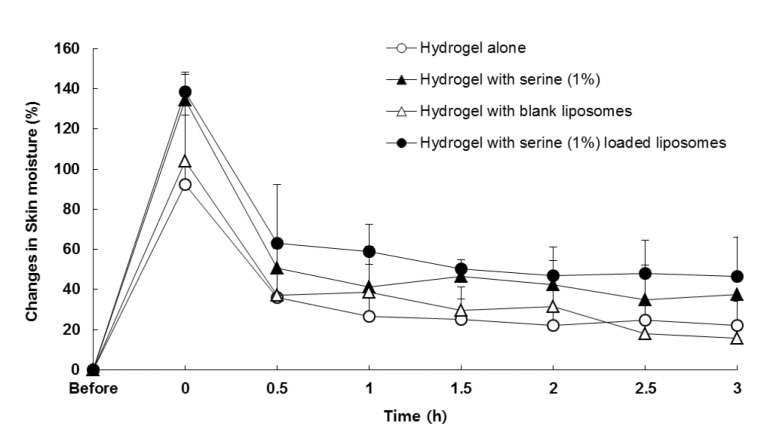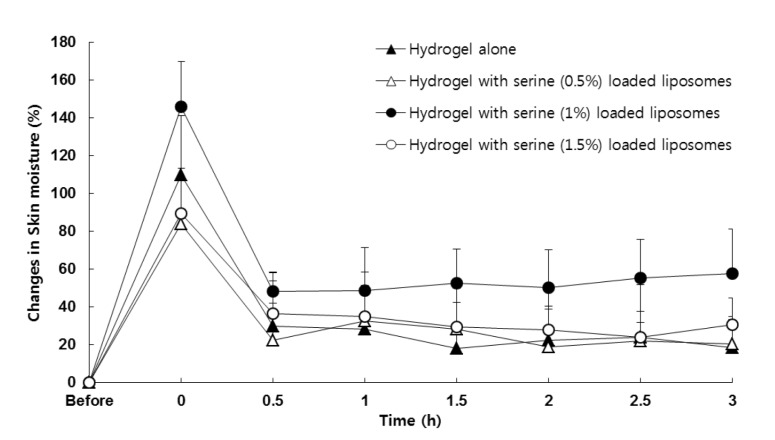Korean J Physiol Pharmacol.
2015 Nov;19(6):543-547. 10.4196/kjpp.2015.19.6.543.
Combined Skin Moisturization of Liposomal Serine Incorporated in Hydrogels Prepared with Carbopol ETD 2020, Rhesperse RM 100 and Hyaluronic Acid
- Affiliations
-
- 1College of Pharmacy, Chung-Ang University, Seoul 06974, Korea. jaehwi@cau.ac.kr
- 2College of Medicine, Chung-Ang University, Seoul 06974, Korea.
- 3Department of Pharmaceutical Industry Management, Chung-Ang University, Seoul 06974, Korea.
- 4Department of Food Science and Technology, Chung-Ang University, Anseong 17546, Korea.
- 5Erom Co., Ltd., Chuncheon 24441, Korea.
- 6Graduate School of Food and Drug Administration, Chung-Ang University, Seoul 06974, Korea.
- KMID: 2070794
- DOI: http://doi.org/10.4196/kjpp.2015.19.6.543
Abstract
- We investigated the combined moisturizing effect of liposomal serine and a cosmeceutical base selected in this study. Serine is a major amino acid consisting of natural moisturizing factors and keratin, and the hydroxyl group of serine can actively interact with water molecules. Therefore, we hypothesized that serine efficiently delivered to the stratum corneum (SC) of the skin would enhance the moisturizing capability of the skin. We prepared four different cosmeceutical bases (hydrogel, oil-in-water (O/W) essence, O/W cream, and water-in-oil (W/O) cream); their moisturizing abilities were then assessed using a Corneometer(R). The hydrogel was selected as the optimum base for skin moisturization based on the area under the moisture content change-time curves (AUMCC) values used as a parameter for the water hold capacity of the skin. Liposomal serine prepared by a reverse-phase evaporation method was then incorporated in the hydrogel. The liposomal serine-incorporated hydrogel (serine level=1%) showed an approximately 1.62~1.77 times greater moisturizing effect on the skin than those of hydrogel, hydrogel with serine (1%), and hydrogel with blank liposome. However, the AUMCC values were not dependent on the level of serine in liposomal serine-loaded hydrogels. Together, the delivery of serine to the SC of the skin is a promising strategy for moisturizing the skin. This study is expected to be an important step in developing highly effective moisturizing cosmeceutical products.
Keyword
MeSH Terms
Figure
Reference
-
1. Washington N, Washington C, Wilson CG. Transdermal drug delivery. In : Washington N, Washington C, Wilson CG, editors. Physiological pharmaceutics: Barriers to drug absorption. 2nd ed. London: Taylor and Francis;2001. p. 181–198.2. Rawlings AV, Harding CR. Moisturization and skin barrier function. Dermatol Ther. 2004; 17(Suppl 1):43–48. PMID: 14728698.
Article3. Nakagawa N, Naito S, Yakumaru M, Sakai S. Hydrating effect of potassium lactate is caused by increasing the interaction between water molecules and the serine residue of the stratum corneum protein. Exp Dermatol. 2011; 20:826–831. PMID: 21771099.
Article4. Lee H, Ha H, Lee JK, Park SJ, Jeong SI, Shin HK. The leaves of Broussonetia kazinoki siebold inhibit atopic dermatitis-like response on mite allergen-treated Nc/Nga mice. Biomol Ther (Seoul). 2014; 22:438–444. PMID: 25414775.
Article5. Verdier-Sévrain S, Bonté F. Skin hydration: a review on its molecular mechanisms. J Cosmet Dermatol. 2007; 6:75–82. PMID: 17524122.
Article6. Zhou XM, Idler WW, Steven AC, Roop DR, Steinert PM. The complete sequence of the human intermediate filament chain keratin 10 Subdomainal divisions and model for folding of end domain sequences. J Biol Chem. 1988; 263:15584–15589. PMID: 2459124.
Article7. Nguyen XK, Lee J, Shin EJ, Dang DK, Jeong JH, Nguyen TT, Nam Y, Cho HJ, Lee JC, Park DH, Jang CG, Hong JS, Nabeshima T, Kim HC. Liposomal melatonin rescues methamphetamine-elicited mitochondrial burdens, pro-apoptosis, and dopaminergic degeneration through the inhibition PKCδ gene. J Pineal Res. 2015; 58:86–106. PMID: 25407782.
Article8. Kim H, Kim Y, Lee J. Liposomal formulations for enhanced lymphatic delivery. Asian J Pharm Sci. 2013; 8:96–103.9. Piérard-Franchimont C, Letawe C, Goffin V, Piérard GE. Skin water-holding capacity and transdermal estrogen therapy for menopause: a pilot study. Maturitas. 1995; 22:151–154. PMID: 8538484.
Article10. Matsumoto T, Yuasa H, Kai R, Ueda H, Ogura S, Honda Y. Skin capacitance in normal and atopic infants, and effects of moisturizers on atopic skin. J Dermatol. 2007; 34:447–450. PMID: 17584321.
Article11. Betz G, Aeppli A, Menshutina N, Leuenberger H. In vivo comparison of various liposome formulations for cosmetic application. Int J Pharm. 2005; 296:44–54. PMID: 15885454.
Article12. Leite e Silva VR, Schulman MA, Ferelli C, Gimenis JM, Ruas GW, Baby AR, Velasco MV, Taqueda ME, Kaneko TM. Hydrating effects of moisturizer active compounds incorporated into hydrogels: in vivo assessment and comparison between devices. J Cosmet Dermatol. 2009; 8:32–39. PMID: 19250164.13. Debbasch C, De La Salle SB, Brignole F, Rat P, Warnet JM, Baudouin C. Cytoprotective effects of hyaluronic acid and Carbomer 934P in ocular surface epithelial cells. Invest Ophthalmol Vis Sci. 2002; 43:3409–3415. PMID: 12407150.14. Chandar P, Nole G, Johnson AW. Understanding natural moisturizing mechanisms: implications for moisturizer technology. Cutis. 2009; 84(1 Suppl):2–15. PMID: 19702109.15. Ghanbarzadeh S, Khorrami A, Arami S. Preparation of optimized naproxen nano liposomes using response surface methodology. J Pharm Invest. 2014; 44:33–39.
Article
- Full Text Links
- Actions
-
Cited
- CITED
-
- Close
- Share
- Similar articles
-
- Alginate-Hyaluronic Acid-Collagen Composite Hydrogel Favorable for the Culture of Chondrocytes and Their Phenotype Maintenance
- Bone Morphogenetic Protein-2 Sustained Delivery by Hydrogels with Microspheres Repairs Rabbit Mandibular Defects
- Hyaluronidase: An overview of its properties, applications, and side effects
- A Case of Delayed Hypersensitivity Reaction due to Hyaluronic Acid (Restylane(R))
- Behavior of Fibroblasts on a Porous Hyaluronic Acid Incorporated Collagen Matrix




